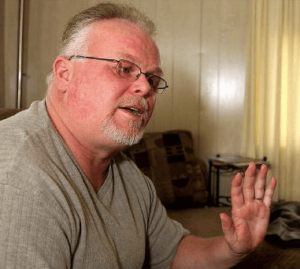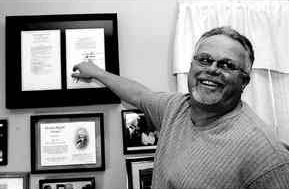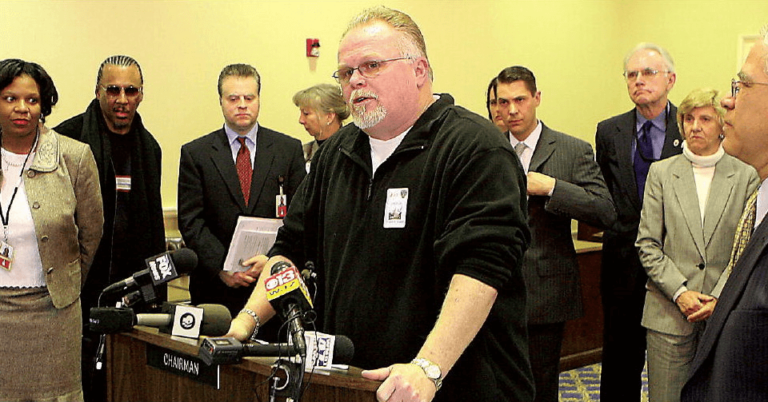
CAMBRIDGE – If anyone has experienced sheer terror, it’s Kirk Bloodsworth.
Tried and found guilty of the brutal rape and murder of a 9-year-old Rosedale girl, the barrel-chested crabber from the Eastern Shore was sentenced to die in the gas chamber for his horrific crimes.
But Mr. Bloodsworth didn’t have anything to do with what he was accused of. A former marine with no criminal record, he had been wrongly convicted and would later become the first American on death row to be exonerated by DNA testing.
But as he was led onto the grounds of the Maryland State Penitentiary in Baltimore in 1985 his first day on death row, no one believed his story – least of all the other prisoners.
Handcuffed and shackled as he slowly made his way across the yard of the penitentiary, Mr. Bloodsworth noticed other prisoners racing to the fences to glimpse the monster they had heard so much about.
This was the man a Baltimore County jury convicted of beating Dawn Hamilton with a rock, sexually mutilating her, raping her and strangling her to death by stepping on her neck.
As the new prisoner shuffled onto the old prison campus, he was dwarfed by the gothic structure’s tall granite walls, silver spires and imposing turrets that loomed ominously over Forrest Street like a medieval castle.
Jeering at him, the inmates shouted repeated threats of violence.
“We’re going to do to you what you did to that little girl,” they screamed. “We’re going to get you, Kirk!”
Seated on the couch in the living room of his small home in Cambridge more than 20 years later, pain was still visible on Mr. Bloodsworth’s face as he recalled those long-ago events that forever changed his life. With his brow deeply furrowed, the plainspoken 46-year-old man said he believed hell is a place of torment and that his experiences must be similar to those in that place of misery.
“I remember that first night in my cell and the smell coming from this place,” he said, recounting how roaches frequently scurried along the walls of his small living quarters.
“Not only did it stink of every kind of excrement you could think of,” he said, “but you also could smell hatred – and it was all pointing at me.”
The threats that greeted him when he first entered the state penitentiary continued through the night and beyond, with inmates shouting through the air vents how they planned to torture him.
Despite the strong temptation to despair, Mr. Bloodsworth said he decided he would fight to prove his innocence. He believes God sustained him through nearly nine years of taxing prison life, sending him otherworldly consolations and leading him into the Catholic Church.
With the same steely determination that got him through his prison ordeal, Mr. Bloodsworth is now devoting the rest of his life to abolishing the death penalty and seeking reforms of what he calls a “broken” criminal justice system.
It’s a battle he is convinced he has been called to win.
A journey of faith
On the day he was found guilty, Mr. Bloodsworth said he remembers being housed in a Baltimore County holding cell with another man who sat in the shadows. For two hours, the stranger didn’t say a word as he ate a sandwich and sipped an orange drink. Then he turned to his fellow prisoner and told Mr. Bloodsworth not to worry. The Eastern Shore native couldn’t tell if the man was black or white because there wasn’t much lighting, which he said was “odd.”
“Everything is going to be alright,” Mr. Bloodsworth recalled the man saying. “You’ll be okay.”
After Mr. Bloodsworth heard the guilty verdict and returned to the holding cell, the man was gone and only half the sandwich remained. When he asked the sheriff’s deputy where the “other guy” was, the deputy responded that Mr. Bloodsworth had been the only person in the cell.
Looking back, Mr. Bloodsworth thinks he was visited by an angel.
“Maybe I wanted to see something – I don’t know,” Mr. Bloodsworth said, pausing to light up a cigarette – the white smoke of which swirled in soft vaporous pirouettes near his now-graying hair.
“But I tell you what, he was as real as you are,” he said emphatically.
The encounter with the “angel” wasn’t Mr. Bloodsworth’s only dealing in the spiritual realm. Another time, he remembers being touched on the shoulder with two fingers while he was alone in his cell. He thinks it was a sign from God that he wasn’t really alone.
Growing up in the Baptist and Methodist traditions, Mr. Bloodsworth had attended a small Christian high school and had counted himself a believer. His mother was a deeply devoted Christian who encouraged him to read the Bible – an assignment he took up in earnest in prison, reading through the entire Scriptures twice.
As a young man, Mr. Bloodsworth had worked for a funeral home where his only exposure to Catholics came during funeral liturgies. That’s where he first learned to genuflect and was impressed by the reverence Catholics showed in the practice of their faith.
While in custody with Baltimore County before going to death row, parishioners from the Church of the Immaculate Conception in Towson visited him and other prisoners during regular chapel services.
Encouraged by their visits, it was at the Maryland State Penitentiary where Mr. Bloodsworth began deep theological discussions with Deacon Al Rose, the Catholic prison chaplain there. The two would talk for two or three hours at a time. The more he learned, the more he wanted to convert.
At Easter time in 1989, Bishop John Ricard, Baltimore’s former urban vicar, visited Mr. Bloodsworth at Deacon Rose’s invitation. Mr. Bloodsworth had been studying his catechism for several months and was ready to be received into the church.
Deacon Rose remembered that a guard asked the bishop to leave Mr. Bloodsworth’s cell, requiring the urban vicar to administer the sacraments of Confirmation and Holy Eucharist through the bars of his closed cell door. Standing underneath the gas chamber where Mr. Bloodsworth’s life was to be ended, Bishop Ricard completed the solemn rites that initiated him into a new kind of life – a spiritual one Mr. Bloodsworth cherished.
Asked what it was like to receive communion for the first time, Mr. Bloodsworth softened his serious countenance and smiled.
“Oh, it was an honor,” he said. “I felt clean. I felt accepted.”
The bond between Deacon Rose and Mr. Bloodsworth was one that strengthened over the years. The Catholic chaplain at the penitentiary for more than three years, Deacon Rose had heard plenty of inmates tell him they were innocent. But Mr. Bloodsworth was one of the few he believed.
“You work enough years among inmates and you get a feel for how guys tell stories,” said Deacon Rose, now retired and ministering at St. Isaac Jogues in Carney. “There was no question in my mind this was a guy speaking the truth.”
One of the darkest days of Mr. Bloodsworth’s time in prison was when his beloved mother, Jeanette Bloodsworth, died five months before the DNA evidence proved his innocence in 1993. Deacon Rose was the one to break the news of the death of Mrs. Bloodsworth to her son. The deacon accompanied him to a private viewing of her body with two armed guards.
“I told Kirk that your mom is up there in heaven,” remembered Deacon Rose, 76. “The saints do intercede for us and I just believe that lady had something to do with him getting the break with the DNA evidence.”
Fighting for justice

Mr. Bloodsworth believes one of the main reasons he was arrested was the tremendous pressure Baltimore County police were under to find the person who had committed those heinous acts in the summer of 1984. Two young boys identified him as the person they saw near the crime scene and an anonymous caller said he had been seen with the girl earlier in the day.
Mr. Bloodsworth, who never met the murdered girl, had told an acquaintance he had done something “terrible” that day. He was referring to his failure to buy his wife dinner, but it was used against him in a wholly different context.
Although he lived in the area of the crime, Mr. Bloodsworth had returned to the Eastern Shore soon after the murder – making it look like he had fled. Misfortune seemed to conspire against him at every turn.
The Maryland Court of Appeals overturned his conviction in 1986 because of withheld information at his original trial, but he was again found guilty by a second jury and sentenced to two consecutive life terms. Of the nearly nine years he spent behind bars, two of them were on death row.
Mr. Bloodsworth was the one who had first proposed the idea of DNA testing. An avid reader in prison who served as the librarian, he learned about the new technology in a book called “The Blooding.” Robert Morin, his attorney, was able to get his client tested.
It was exactly that post-conviction testing that proved Mr. Bloodsworth’s innocence in 1993. He was released and paid $300,000 in compensation – the accumulated salary the state said he would have earned as a waterman over nine years. Gov. William Donald Schaefer pardoned him that same year.
Mr. Bloodsworth said he had to endure the suspicions of many who believed he had gotten off on a technicality. It was difficult for him to maintain a job after his release because people thought he was a murderer. DNA testing later identified the real killer – Kimberly Shay Ruffner, a man who had been previously charged with sexually assaulting children. He pled guilty to the Dawn Hamilton murder and is now serving a life sentence.
Ironically, Ruffner had been serving time for another crime in the same prison as Mr. Bloodsworth. The two had lifted weights together.
“I tell you the difference between the day before they found who really did it and day after was like I had just won the World Series for the town of Cambridge,” said Mr. Bloodsworth, who annually throws a “freedom party” complete with steamed crabs and beer. “Everyone treated me completely different.”
Perhaps unsurprisingly, Mr. Bloodsworth, now remarried, has become an outspoken advocate for the abolition of the death penalty, most recently speaking in Annapolis in support of a bill that would replace the death penalty with prison sentences of life without parole.
Working for The Justice Project, a Washington-based organization that pushes for criminal justice reform, Mr. Bloodsworth lobbied for the passage of a bill that provides funding for post-conviction DNA testing. President George W. Bush signed the Innocence Protection Act of 2003 on Oct. 30, a day before Mr. Bloodsworth’s birthday. The act established the Kirk Bloodsworth Post-conviction DNA Testing Program.
“We need to do post-conviction testing to find out if there are other innocent people on death row before we start throwing switches,” said Mr. Bloodsworth, pointing out that since 1973, more than 100 people have been exonerated from death row after being cleared of their charges. More than 150 people have been wrongfully convicted and later freed from prison based on DNA evidence, he said.
“If it can happen to me, it can happen to anyone,” he said sternly, repeating a sentence he has declared hundreds of times around the country.
Bishop Ricard, the man who welcomed Mr. Bloodsworth into the church, said his story shows the urgency of abolishing the death penalty.
“It’s a barbarian, grotesque way of meting out justice,” said Bishop Ricard, now bishop of the Diocese of Pensacola-Tallahassee, Fla.
“It’s so clear that the administration of capital punishment in this country is dismally unjust,” he said. “It really singles out the poor and minorities. If you have the money for proper legal counsel, you don’t receive the death penalty.”
Bishop Ricard commended Mr. Bloodsworth for his contributions to the abolitionist cause.
“I hope the very best for him,” he said.
Deacon Rose said he too has the deepest admiration for his friend.
“He could have been so bitter when he got out,” Deacon Rose said. “With God’s help, he took an incredible evil and got some good results. Not everyone can do that.”
Forgiveness and fate
Mr. Bloodsworth acknowledged that he might have good reason to be angry for all he’s been through. But he doesn’t hate the prosecutors who pursued him, the police officers who arrested him, members of the community who distrusted and harassed him or the real killer who kept quiet all those years.
“I forgive them all,” Mr. Bloodsworth said. “God has to sort that out now. I leave that all up to him.”
The former national discus-throwing champion admitted to some actions in prison that don’t square with his Catholic faith. Early during his sentence, he fended off an attack by three prisoners in the shower. In order to prevent future attacks, he later physically assaulted each of them.
“I don’t know if it was the right thing to do, but it was the right thing to do for me,” he said. “I’m not proud of it at all, but it probably saved my life in the end.”
Returning to the importance of faith, Mr. Bloodsworth said his belief in God made him a survivor.
“We all go through these trials in life,” he said. “You just have to kind of accept what happens to you with some sort of grace, however that is.”
God never asks his people to have faith the size of a mountain, Mr. Bloodsworth said, he just asks to have faith the size of mustard seed to “move that mountain.”
“That’s what makes people achieve greatness,” he said. “It’s not necessarily themselves, it’s the electricity that drives them – it’s that lump of coal that’s burning bright in their own soul that gets them through it and for me that’s God, the Catholic Church and my mother and what she taught me.”
Does he see any divine plan in the course of his life?
“I don’t want to sound like I’m grandiose on my part, but it’s certainly something,” Mr. Bloodsworth responded.
“In the bigger sense of it all, I think that maybe that was all meant to be,” he said. “There is a bigger picture.”
Email George Matysek at gmatysek@CatholicReview.org.
Copyright © 2007 Catholic Review Media


